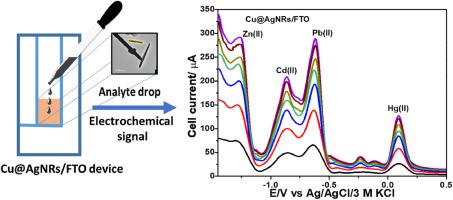当前位置:
X-MOL 学术
›
Mater. Chem. Phys.
›
论文详情
Our official English website, www.x-mol.net, welcomes your feedback! (Note: you will need to create a separate account there.)
Ultrasensitive electrochemical sensors based on Cu and Cu@Ag nanorods for simultaneous heavy metal detection
Materials Chemistry and Physics ( IF 4.6 ) Pub Date : 2024-03-28 , DOI: 10.1016/j.matchemphys.2024.129255 Smruti Ranjan Dash , Subhendu Sekhar Bag , Animes Kumar Golder , Aruna Ivaturi
Materials Chemistry and Physics ( IF 4.6 ) Pub Date : 2024-03-28 , DOI: 10.1016/j.matchemphys.2024.129255 Smruti Ranjan Dash , Subhendu Sekhar Bag , Animes Kumar Golder , Aruna Ivaturi

|
This work reports the development of ultrasensitive miniaturized electrochemical device for heavy metal sensing. A laser engraver based patterning of fluorine-doped tin oxide (FTO) sheet was done to draw an etched pattern forming a miniaturized 3-electrode configuration. A layer of Ag/AgCl ink served as pseudo-reference electrode. The sensing electrode was coated using low-cost Cu nanorods (CuNRs) grown radially along the {110} surface with aspect ratio of 8.0 and Cu@Ag core-shell nanorods (Cu@AgNRs) formed via galvanic displacement for simultaneous electrocatalytic detection of heavy metal ions (Pb(II), Cd(II), Hg(II), and Zn(II)) present in water. The electroactive surface area of the prepared devices is 0.026, 0.093 and 0.125 cm for bare FTO, CuNRs/FTO and Cu@AgNRs/FTO, respectively. Bimetal Cu@AgNRs/FTO sensor exhibited the lowest limit of detection of 1, 2, 5 and 6 nM, respectively, detecting Cd(II), Pb(II), Zn(II), and Hg(II) ions, and it was 2, 2, 3 and 4 nM, respectively, for simultaneous detection of Zn(II), Pb(II), Cd(II) and Hg(II). The Cu@AgNRs/FTO based device showed distinct peak-to-peak separation by 0.40, 0.25 and 0.51 V for Zn(II)-Cd(II), Cd(II)-Pb(II) and Pb(II)-Hg(II), respectively. This device was highly sensitive (583.6–1261.8 μA․μM․cm) for heavy metal detection over CuNRs/FTO (15.9–107.4 μA․μM․cm). The Cu@AgNRs/FTO based sensors demonstrated good reproducibility (relative standard deviation ≤ 5%) with recovery (>90%) in the case of all target heavy metals simultaneously present in environmental water samples. Hence, the Cu nanorods based miniaturized sensing platforms developed in the present study for simultaneous heavy metal detection are potential low-cost alternatives providing a repeatability of upto 4 cycles unlike the commercial screen-printed electrodes.
中文翻译:

基于 Cu 和 Cu@Ag 纳米棒的超灵敏电化学传感器,用于同时检测重金属
这项工作报告了用于重金属传感的超灵敏小型电化学装置的开发。对掺氟氧化锡 (FTO) 片材进行基于激光雕刻机的图案化,以绘制形成小型化三电极配置的蚀刻图案。一层 Ag/AgCl 墨水用作伪参比电极。传感电极涂有沿{110}表面径向生长的低成本铜纳米棒(CuNRs),纵横比为8.0,以及通过电位移形成的Cu@Ag核壳纳米棒(Cu@AgNRs),用于同时电催化检测重金属水中存在的金属离子(Pb(II)、Cd(II)、Hg(II) 和 Zn(II))。对于裸FTO、CuNRs/FTO和Cu@AgNRs/FTO,所制备的器件的电活性表面积分别为0.026、0.093和0.125 cm2。双金属Cu@AgNRs/FTO传感器的最低检测限分别为1、2、5和6 nM,可检测Cd(II)、Pb(II)、Zn(II)和Hg(II)离子,并且分别为 2、2、3 和 4 nM,用于同时检测 Zn(II)、Pb(II)、Cd(II) 和 Hg(II)。基于 Cu@AgNRs/FTO 的器件对 Zn(II)-Cd(II)、Cd(II)-Pb(II) 和 Pb(II)-Hg 表现出明显的峰峰分离度,分别为 0.40、0.25 和 0.51 V (二)分别。该装置对重金属检测的灵敏度高于 CuNRs/FTO (15.9–107.4 μA․μM․cm) (583.6–1261.8 μA․μM․cm)。当环境水样中同时存在所有目标重金属时,基于 Cu@AgNRs/FTO 的传感器表现出良好的重现性(相对标准偏差 ≤ 5%)和回收率(>90%)。因此,本研究中开发的用于同步重金属检测的基于铜纳米棒的微型传感平台是潜在的低成本替代品,与商业丝网印刷电极不同,可提供高达 4 个周期的重复性。
更新日期:2024-03-28
中文翻译:

基于 Cu 和 Cu@Ag 纳米棒的超灵敏电化学传感器,用于同时检测重金属
这项工作报告了用于重金属传感的超灵敏小型电化学装置的开发。对掺氟氧化锡 (FTO) 片材进行基于激光雕刻机的图案化,以绘制形成小型化三电极配置的蚀刻图案。一层 Ag/AgCl 墨水用作伪参比电极。传感电极涂有沿{110}表面径向生长的低成本铜纳米棒(CuNRs),纵横比为8.0,以及通过电位移形成的Cu@Ag核壳纳米棒(Cu@AgNRs),用于同时电催化检测重金属水中存在的金属离子(Pb(II)、Cd(II)、Hg(II) 和 Zn(II))。对于裸FTO、CuNRs/FTO和Cu@AgNRs/FTO,所制备的器件的电活性表面积分别为0.026、0.093和0.125 cm2。双金属Cu@AgNRs/FTO传感器的最低检测限分别为1、2、5和6 nM,可检测Cd(II)、Pb(II)、Zn(II)和Hg(II)离子,并且分别为 2、2、3 和 4 nM,用于同时检测 Zn(II)、Pb(II)、Cd(II) 和 Hg(II)。基于 Cu@AgNRs/FTO 的器件对 Zn(II)-Cd(II)、Cd(II)-Pb(II) 和 Pb(II)-Hg 表现出明显的峰峰分离度,分别为 0.40、0.25 和 0.51 V (二)分别。该装置对重金属检测的灵敏度高于 CuNRs/FTO (15.9–107.4 μA․μM․cm) (583.6–1261.8 μA․μM․cm)。当环境水样中同时存在所有目标重金属时,基于 Cu@AgNRs/FTO 的传感器表现出良好的重现性(相对标准偏差 ≤ 5%)和回收率(>90%)。因此,本研究中开发的用于同步重金属检测的基于铜纳米棒的微型传感平台是潜在的低成本替代品,与商业丝网印刷电极不同,可提供高达 4 个周期的重复性。



























 京公网安备 11010802027423号
京公网安备 11010802027423号